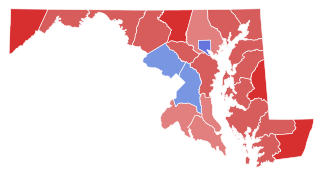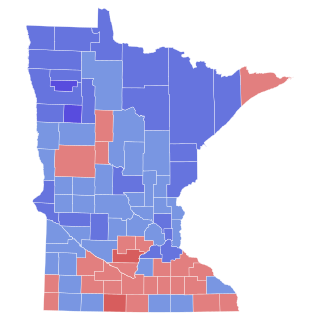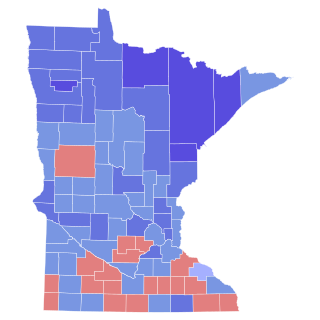
The 1984 United States Senate elections were held on November 6, with the 33 seats of Class 2 contested in regular elections. They coincided with the landslide re-election of President Ronald Reagan in the presidential election. In spite of the lopsided presidential race, Reagan's Republican Party suffered a net loss of two Senate seats to the Democrats, although it retained control of the Senate with a reduced 53–47 majority. Democrats defeated incumbents in Illinois and Iowa, and won an open seat in Tennessee, while Republicans defeated an incumbent in Kentucky.

The 1978 United States Senate elections were held on November 7, in the middle of Democratic President Jimmy Carter's term. The 33 seats of Class 2 were contested in regular elections. Special elections were also held to fill vacancies.

The 1972 United States Senate elections were held on November 7, with the 33 seats of Class 2 contested in regular elections. They coincided with the landslide re-election of Republican President Richard Nixon. Despite Nixon's landslide victory, Democrats increased their majority by two seats. The Democrats picked up open seats in Kentucky and South Dakota, and defeated four incumbent senators: Gordon Allott of Colorado, J. Caleb Boggs of Delaware, Jack Miller of Iowa, and Margaret Chase Smith of Maine. The Republicans picked up open seats in New Mexico, North Carolina, and Oklahoma, and defeated one incumbent, William B. Spong Jr. of Virginia.

The 1970 United States Senate elections was an election for the United States Senate. It took place on November 3, with the 33 seats of Class 1 contested in regular elections. Special elections were also held to fill vacancies. These races occurred in the middle of Richard Nixon's first term as president. The Democrats lost a net of three seats, while the Republicans and the Conservative Party of New York picked up one net seat each, and former Democrat Harry F. Byrd Jr. was re-elected as an independent.

The 1966 United States Senate elections were elections on November 8, 1966, for the United States Senate which occurred midway through the second term of President Lyndon B. Johnson. The 33 seats of Class 2 were contested in regular elections. Special elections were also held to fill vacancies. With divisions in the Democratic base over the Vietnam War, and with the traditional mid-term advantage of the party not holding the presidency, the Republicans took three Democratic seats, thereby breaking Democrats' 2/3rds supermajority. Despite Republican gains, the balance remained overwhelmingly in favor of the Democrats, who retained a 64–36 majority. Democrats were further reduced to 63–37, following the death of Robert F. Kennedy in June 1968.

The 1964 United States Senate elections were held on November 3. The 33 seats of Class 1 were contested in regular elections. Special elections were also held to fill vacancies. They coincided with the election of President Lyndon B. Johnson by an overwhelming majority, to a full term. His Democratic Party picked up a net two seats from the Republicans. As of 2023, this was the last time either party has had a two-thirds majority in the Senate, which allowed the Senate Democrats to override a veto, propose constitutional amendments, or convict and expel certain officials without any votes from Senate Republicans. However, internal divisions would have prevented the Democrats from having done so. The Senate election cycle coincided with Democratic gains in the House in the same year.

The 1958 United States Senate elections were elections for the United States Senate which occurred in the middle of President Dwight D. Eisenhower's second term. Thirty-two seats of Class 1 were contested in regular elections, the new state of Alaska held its first Senate elections for its Class 2 and 3 seats, and two special elections were held to fill vacancies.

The 1932 United States Senate elections coincided with Democrat Franklin D. Roosevelt's landslide victory over incumbent Herbert Hoover in the presidential election. The 32 seats of Class 3 were contested in regular elections, and special elections were held to fill vacancies.

Electoral history of Walter Mondale, who served as the 42nd vice president of the United States (1977–1981); as a United States senator from Minnesota (1964–1976), and as the 23rd attorney general of Minnesota (1960–1964).

The 1980 United States Senate election in Utah took place on November 4, 1980.

The 1976 United States Senate election in Florida was held on November 2, 1976. Incumbent Democratic U.S. Senator Lawton Chiles won re-election to a second term.

The 1932 United States Senate elections in Arizona took place on November 8, 1932. Incumbent Democratic U.S. Senator Carl Hayden ran for reelection to a second term, again defeating his 1926 challenger former U.S. Senator Ralph H. Cameron in the general election.

The 1970 United States Senate election in Maryland took place on November 3, 1970. Incumbent Democratic U.S. Senator Joseph Tydings ran for re-election to a second term, but was narrowly defeated by Republican U.S. Representative J. Glenn Beall Jr.

The 1960 United States Senate election in Minnesota took place on November 8, 1960. Incumbent Democratic U.S. Senator Hubert H. Humphrey defeated Republican Minneapolis Mayor P. Kenneth Peterson, to win a third term.

The 1966 United States Senate election in Iowa took place on November 8, 1966. Incumbent Republican Senator Jack Miller was re-elected to a second term in office over Democrat E.B. Smith.

The 1966 United States Senate election in Tennessee was held on November 8, 1966, concurrently with other elections to the United States Senate in other states as well as elections to the United States House of Representatives and various state and local elections. Republican nominee Howard Baker won the election, defeating Democratic nominee and Tennessee Governor Frank G. Clement with 55.7% of the vote.

The 1968 United States Senate election in Colorado took place on November 5, 1968. Incumbent Republican U.S. Senator Peter Dominick was re-elected to a second term in office over Democratic ex-Governor Stephen McNichols. Peter Dominick defeated Stephen McNichols in a landslide despite Richard Nixon, a fellow Republican to Peter Dominick, winning the state narrowly over Hubert Humphrey in the concurrent presidential election.

The 1970 United States Senate election in Minnesota took place on November 3, 1970. Incumbent Democratic U.S. Senator Eugene McCarthy opted not to seek reelection. Former Democratic U.S. Senator, former Vice President and 1968 presidential nominee Hubert Humphrey defeated Republican U.S. Representative Clark MacGregor.

The 1972 United States Senate election in Minnesota took place on November 7, 1972. Incumbent Democratic U.S. Senator Walter Mondale won re-election. Minnesota was one of fifteen states alongside Alabama, Arkansas, Colorado, Delaware, Georgia, Iowa, Louisiana, Maine, Mississippi, Montana, New Hampshire, Rhode Island, South Dakota and West Virginia that were won by Republican President Richard Nixon in 1972 that elected Democrats to the United States Senate.

The 1977 United States House of Representatives special election in Minnesota's 7th congressional district was held on February 22, 1977 to select the successor to Bob Bergland (DFL) who resigned to accept appointment as Secretary of Agriculture under the Carter Administration. Independent-Republican candidate Arlan Stangeland defeated the DFL favorite, Mike Sullivan, in an upset landslide.























